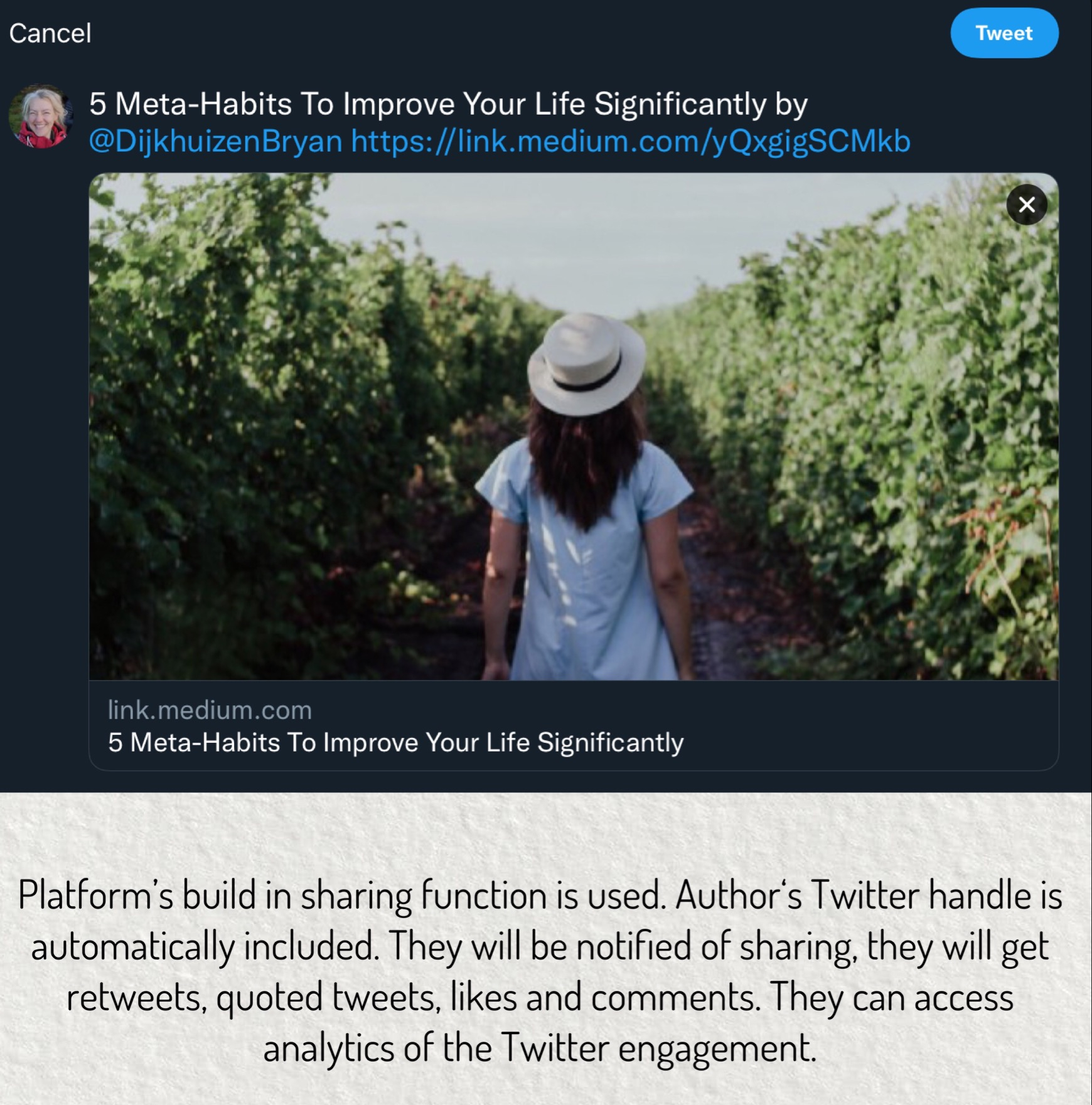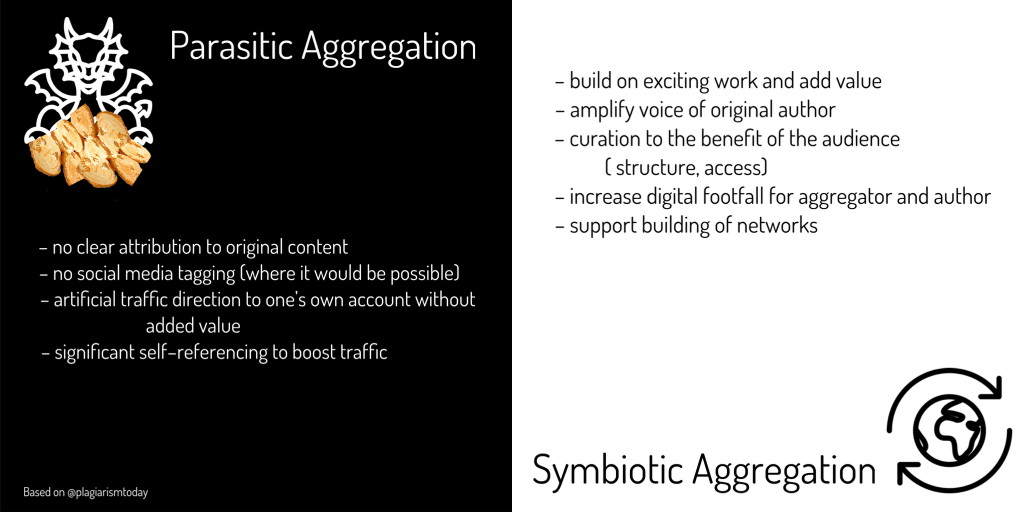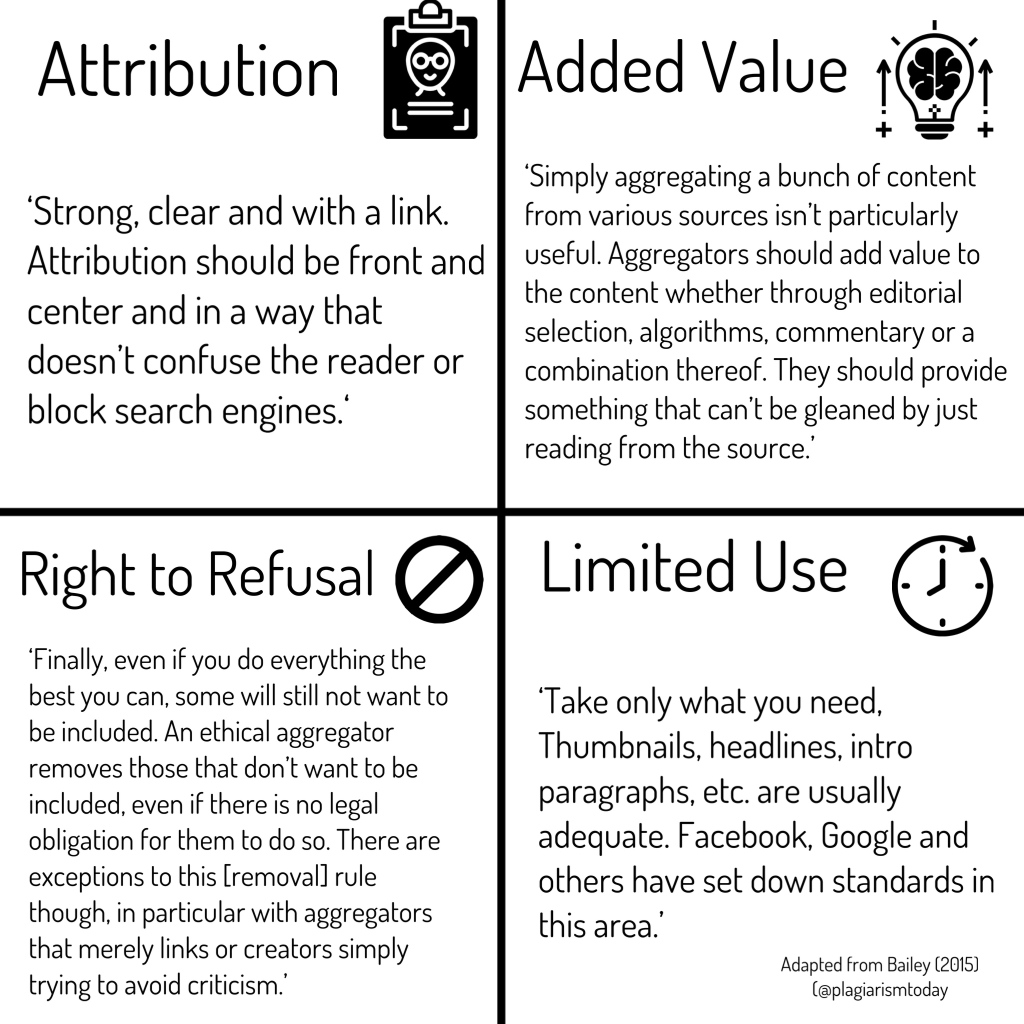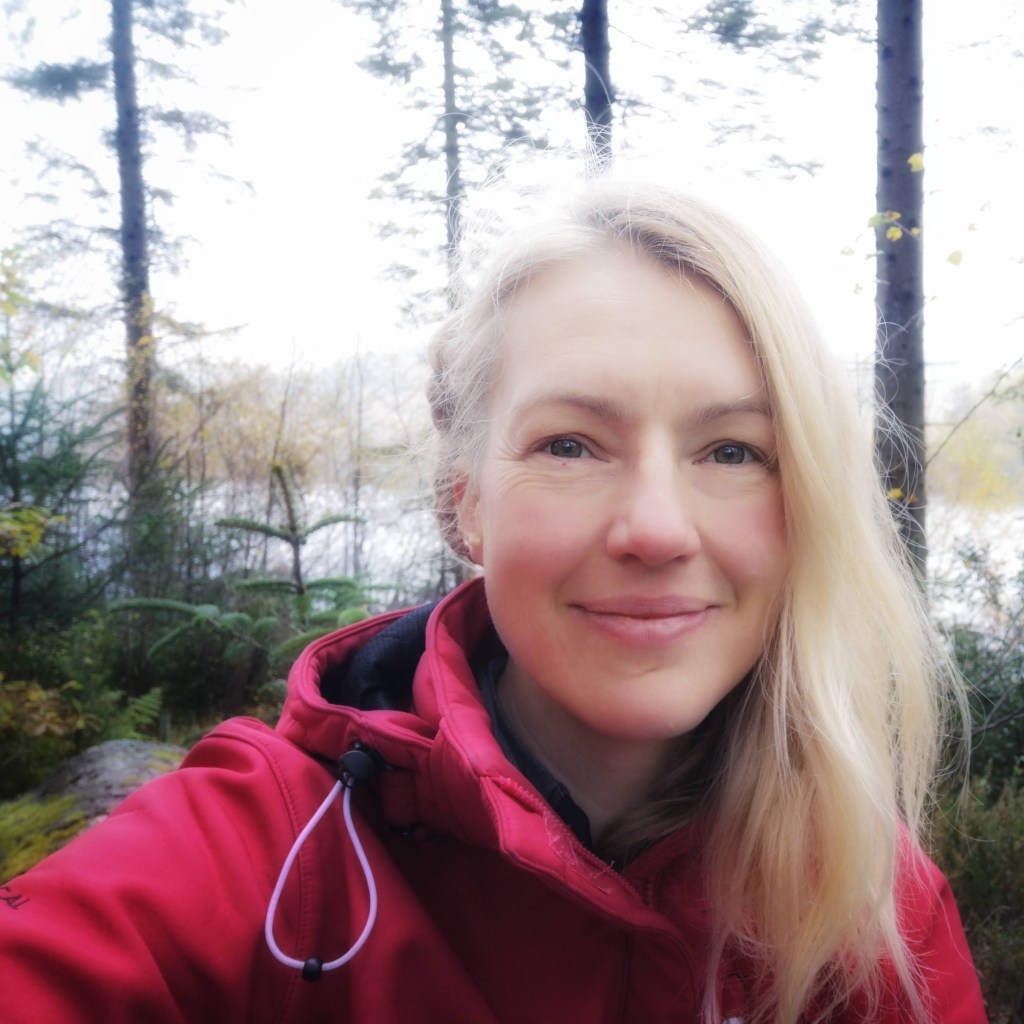Led by: Dr Linnea Soler @DrLinneaSoler & Dr Nathalie Tasler @drntasler

“There’s often a thin line between aggregation and theft. Sending readers to savor the work of others at the sites where they publish — that’s one thing. Excerpting or paraphrasing at length, so the original sources doesn’t get the traffic or the revenue, that’s something else.”
Keller (2011)–former executive editor of The New York Times
Bear with us! This is a topic we only recently encountered. There is not much guidance besides resources for journalists. So, after explaining the terminology, and why this topic matters in terms of digital impact, we are walking you through four good practice steps that are suggested for journalism. We would like to hear about your own experience, viewpoints, and how we can collaboratively turn this into good practice guidelines for social media.
Aggregation, the Good, the Bad, the Ugly
Jonathan Bailey, states that “If you use or link to other content, you are probably an aggregator, at least in some capacity” (Bailey, 2010) and then follows with ‘we are all aggregators’ (Bailey, 2015). But there are different approaches to aggregation and, depending on how transparent the attribution is, these can be classified either as parasitic or symbiotic. We believe that transparency (Silverman, 2014) and how attribution is carried out seem to underpin these critical differences.
“Ethical aggregators try to find ways to build upon and add value to the works of others while supporting the original creator” (Bailey, 2015) So symbiotic aggregation helps add exposure to the original author through transparent attribution, thereby facilitating reader access to the original material. It also, through careful aggregation (curation), helps the readers access interesting and topical information. In doing this, symbiotic aggregators are helping to expand the footfall and digital impact for both the original author and for themselves. However, parasitic aggregation results when there is no clear attributions to the original content – this muddies the water and confuses the audience as to where the material originated. It also cuts the link of digital impact metrics for the original author and shunts this impact to the parasite (Bailey, 2015 & Silverman, 2014)
What makes this topic so professionally relevant to us (and very likely to you)?: No matter what path you are on in HE, impact and esteem measures become more relevant for career progressions. Consider the following example: you share your work and a screenshot is taken, including your name, and this is shared more widely, without tagging; this could be considered to be referenced sharing, technically. However, you do not get the statistics from any of the subsequent engagement with your screen-shotted resource. So, the person who shares your work this way, will benefit from any likes, comments, retweets, quoted tweets but these activities will not show in your analytics. Therefore, you are cut out of the impact circle of your own work. A similar scraping approach happens if someone re-creates your tweets and shares these without tagging you as an author.
The short version:
We sought guidance on ethical sharing using social media in HE and came across Bailey’s (2015) four criteria that characterise fair sharing of content (see below).
Attribution: Strong, clear and with a link. Attribution should be front and center and in a way that doesn’t confuse the reader or block search engines.
Limited Use: Take only what you need, Thumbnails, headlines, intro paragraphs, etc. are usually adequate. Facebook, Google and others have set down standards in this area.
Added Value: Simply aggregating a bunch of content from various sources isn’t particularly useful. Aggregators should add value to the content whether through editorial selection, algorithms, commentary or a combination thereof. They should provide something that can’t be gleaned by just reading from the source.
Right of Refusal: Finally, even if you do everything the best you can, some will still not want to be included. An ethical aggregator removes those that don’t want to be included, even if there is no legal obligation for them to do so. There are exceptions to this rule though, in particular with aggregators that merely links or creators simply trying to avoid criticism.
(Bailey, 2015)
The Longer Version:
As we engaged with these four characteristics of symbiotic aggregation, and developed examples of each as we tussled with understanding them.
Attribution–Example
This is not always as straightforward as you might think. One of the most common example of parasitic aggregation that we have seen the is sharing of content without transparent links to its owner. In a ‘parasitic share’ we would simply copy and paste the URL of the webpost. On the other hand, the same material can be shared symbiotically. We share below a simulated example good practice of symbiotic aggregation where you can clearly see both the original author’s Twitter handle and the link to their original web post. This approach ensures that, if the author has access to the analytics of the website, they will at least be able to benefit from this amplified impact from from our sharing.
Most websites already have an option to ‘share through [offer of various social media icons]’ to facilitate ethical use. As authors we usually link this to our own Twitter accounts. Sharing media through these icons has several advantages: It saves the symbiotic aggregator effort and time in trying to source the author’s name on Twitter because the author will be automatically tagged in the shared resource. Furthermore, everyone gets the analytics for impact, not only the person who aggregates, but also the original author(s). This also benefits the audience because it helps the readers to link directly with the original author.
What happens if the author has a private Twitter account or is not on Twitter? In this case tagging is not possible. But then, because author does not utilise this form of impact tracking, we think it should be okay to share material as long as due diligence is shown with respect to attributing ownership. What do you think?

Added Value–Example
Adding value can be a difficult aspect that caused a bit of debate amongst us, so we are keen to hear your opinions. We could argue that aggregation in itself is already creating value as it places potentially valuable and interesting resources in one place, and thus saves the audience potentially a lot of time ploughing through resources themselves. From the authors’ points of view it can create value–if the rules of symbiotic sharing are adhered to so that this symbiotic sharing provides more exposure potentially support networking.
We started a list of added value for both the audience and authors, alike, based on @erikasmith very helpful symbiotic aggregation of HE podcasts.
- Saves time
- Categorises the podcasts,
- Easy access,
- It is curated for easy navigation to topical HE podcasts,
- Shareable
- amplifies impact of author’s work
The curator here also includes the link to the original Twitter conversation:
This sharing of the original twitter link enables the audience (and authors) to engage with (other) authors and collaborators if they are interested. This is an excellent example of how the curator practices transparency as well as fostering community building; almost every suggested podcast has several comments below from other HE Twitter users. thereby growing the network.
The following two examples were more challenging to get our heads around, and we tried to share how we made sense of them. We would love to hear from you, if this is something to be included into the use of social media in HE--if so, how so? Here are our thoughts:
Limited Use–Example
If you are familiar with WordPress, the re-blogging function is a very good example of limited use and automatically does this for you ensuring that you “Take only what you need” and that the original author is credited. WordPress allows anyone to re-blog (share someone else’s blogpost on your own blog) a blogpost from another author. However, only the first portion of the original post is accessible on the ‘re-bloggers’ website and the reader, should the wish to engage more fully with the post, is automatically taken to the original article by WordPress.
Right to Refusal–Examples
For us this was one of the trickiest aspects to engage with. Since in most publicly shared content, there seems to be an assumption of permission implied. If we curate sources or use content (all done ethically), and the author wants content removed, we can do this. For this to function, the author must be informed (i.e. by us tagged them in our resource). But is this feasible in all circumstances?
An implied Right to Refusal could also be found by inspecting an inbuilt Twitter mechanism. Look at your Twitter contacts to see if they have a little black lock icon next to their profile. If so, this means that their Tweets are intended to be seen by a limited audience–usually the retweet button is inactive. So, as for the case described before in the Attribution Example, if someone takes a screenshot of a tweet and shares it, either with or without tagging the originator, this would break the limited use rule as the originator clearly wanted to keep the tweet restricted to a particular audience.
These are our thoughts so far. What are your experiences? Do these rules make sense? Is there other good practice more suitable for the use of social media in HE? Do you have any hints and tips you can share with us?
Resources
Thank you @cristinacost for sharing these two papers on strategic communication:
- Habermas on Strategic and Communicative Action on JSTOR
- Communicative versus Strategic Rationality: Habermas Theory of Communicative Action and the Social Brain https://www.ncbi.nlm.nih.gov/pmc/articles/PMC3666968/
Thank you @chrissinerantzi for sharing the following resources
- Use of social media metrics in research evaluation ‘narrow’ https://www.timeshighereducation.com/news/use-social-media-metrics-research-evaluation-narrow via @timeshighered
- Carrigan, M., Jordan, K. Platforms and Institutions in the Post-Pandemic University: a Case Study of Social Media and the Impact Agenda. Postdigit Sci Educ (2021). https://doi.org/10.1007/s42438-021-00269-x
And thank you @FiDaisyG for sharing your explorations of commenalist drogons (seriously you need to look this up!) and providing us with a word for one of the main issues we wanted to explain: a symbiosis in which only one party benefits but not the other (although no harm is done to the other)=commenalism. And also for sharing about epiphytes Epiphytes | Ancient Tree Forum
Digital Scholarship
One of the best brief descriptions we have found online is from University of Washington Library services, and then of course we highly recommend Martin Wellers book The Digital Scholar
We also developed two infographics for you


Last but not least the link to our Wakelet
Links to References
Bailey, J. (2015) A Brief Guide to Ethical Aggregation – Plagiarism Today @plagiarismtoday
Bailey, J. (2010) Are Aggregators Really the Problem? Plagiarism Today (@plagiarismtoday)
Keller, B. (2011) Postscript: Aggregation Aggro The New York Times
Silverman, C. (2014) The best ways for publishers to build credibility through transparency American Press Institute
Additional reading
Foxton, W. (2013) Parasite journalism: is aggregation as bad as plagiarism? The New Statesman
Silverman, C. (2013) Chapter 4- Practice ethical curation and attribution American Press Institute
Hosts for this week’s LTHEchat:
Dr Linnea Soler
Dr Nathalie Tasler
Dr Linnea Soler is a Senior Lecturer in Organic Chemistry (Learning, Teaching & Scholarship track) at the University of Glasgow, where SoTL (Scholarship of Teaching & Learning) plays an important role and underpins both her teaching practice and the development of L&T resources. She has both independent and collaborative SoTL projects, with colleagues in Chemistry and from Engineering, Life Sciences, Social Sciences, and the Arts.
Her interests include the creation of chemistry education resources, often in partnership with final year chemistry undergraduate project students, for use in HE and in secondary school environments. She firmly believes in power of fun and in and the power of technology to make learning more engaging, interactive, and powerful. The need to support student transition into HE and to help foster a sense of belonging is factored into resource design. Linnea is enthralled with Heritage Science chemistry and with the use of technology and creative multimedia approaches to enhance the learning, assessment, and feedback in chemistry labs as well as the need to create fresh new approaches to lab learning.
Dr Nathalie Tasler* is a lecturer in Academic and Digital Development (ADD) at the University of Glasgow. Her background is Erziehungswissenschaften (Sciences of Education) and Doctorate in Education. She leads the University’s Scholarship of Teaching and Learning (SoTL) Network and has a strong background in Creative Learning and Teaching. Nathalie has been involved in various roles in the education sector for over 25 years, initially, in museums and culture education and, for the last 15 years, predominantly in Higher Education.
Nathalie is the SoTL curator for the National Teaching Repository. She sits on the membership committee for the International SoTL Society. She is also a mentor for the ALT ELESIG scholar scheme.
She is a founding editor for the open access SoTL journal “oSoTL” and also hosts SoTLcast, a podcast around all things SoTL (available on all major platforms including Spotify).
If you are interested in resources for and her thoughts on everything related to learning and teaching in higher education you can follow her blog here: Adventures in Academic Development – Faculty Development, Hochschuldidaktik, Play and Creativity in Higher Education, SoTL (acdevadventures.blog) . Nathalie also is a mentor organizing teams for the weekly community-driven twitterchat on themes related to Learning and Teaching in Higher Education #LTHEchat, to which you are invited to participate.More details about her work history are on LinkedIn and if you like poetry you can find some of her creative writing work here.
Questions
Q1 How do you make use of your social media analytics for your career development?
Q2 How is digital scholarship recognised in your institution?
Q3 Has your content been shared without informing (tagging) you? (This is what we call “parasitic aggregation”). How did you feel about it?
Q4 What is the benefit of symbiotic aggregation (attributing and tagging the original creator) for both the author and the aggregator?
Q5 Do you have any hints/tips to help us all become better symbiotic aggregators?
Q6 Should we adapt Bailey’s framework for use in academic practice on social media?
Wakelet: https://wke.lt/w/s/OrmTDQ








Reblogged this on Adventures in Academic Development and commented:
The lovely Dr Linnea Soler and I were trying to understand how to ethically aggregate knowledge, share and amplify colleagues voices through social media. We wrote this blog post sharing our initial findings and thoughts about it.
LikeLiked by 2 people
This article is very useful, especially through the authors’ application of the criteria to examples in practice. And thank you for including my higher education podcast list and the related Twitter discussion as an example of added value! Nathalie and I were chatting about decision-making processes that can inform this kind of curation. I find the term “symbiotic” to be an apt way to describe dynamic ways of engaging within and between different networks, and leveraging openness and the crowd-sourcing of ideas and materials. To help capture and promote such sharing activities, I’ve found that it’s helpful to think about digital artifacts that can be flexible and extendable, even in ephemeral online spaces. For instance, connecting the Twitter thread to a collaborative document (done in this case in Google Docs) has provided an avenue for amplifying the connections between content creators (e.g., podcast hosts, guests) and different potential audiences (e.g., local or global educators, educational developers). An important piece for me was asking questions and actively receiving and responding to threads in these conversations when deciding how the list would be created, as well as thinking through how it could evolve and be shared most widely. Time invested (especially up-front) on authentic two-way communication is worthwhile. It’s rewarding to still receive requests for podcasts to be added to the list, as it’s a living document. And I have been able to share this curation with other educators and educational developers who then use, embed, or build upon this work from other communities.
LikeLiked by 2 people
Thank you so much for your comment Erika! I am still sharing your resource as well and it is great to know it is a live resource or follow up on Twitter for the origins. Thank you for letting us share 🙂
LikeLike
My I make a suggestion, as someone who struggles to follow Twitter chats? Could a post-chat #LTHEchat collation of tweets be posted? Thank you
LikeLiked by 1 person
Hi Alfred, after each chat the team curate the tweets using Wakelet. A link to this is added to the blog post.
LikeLiked by 1 person
Pingback: Public Participation: An Emotional Rollercoaster – Adventures in Academic Development